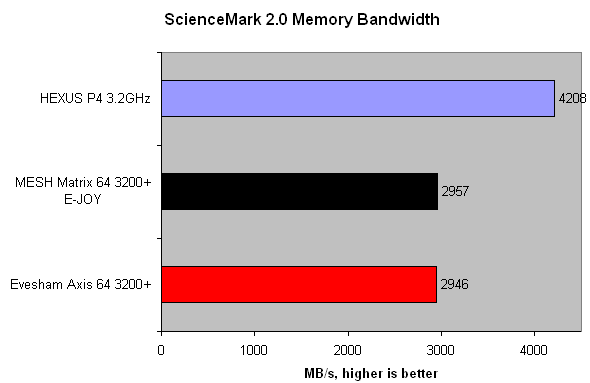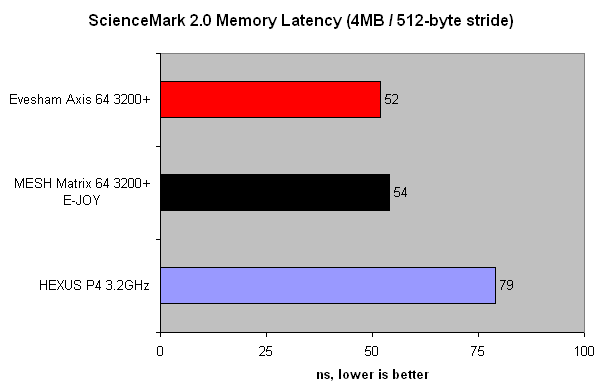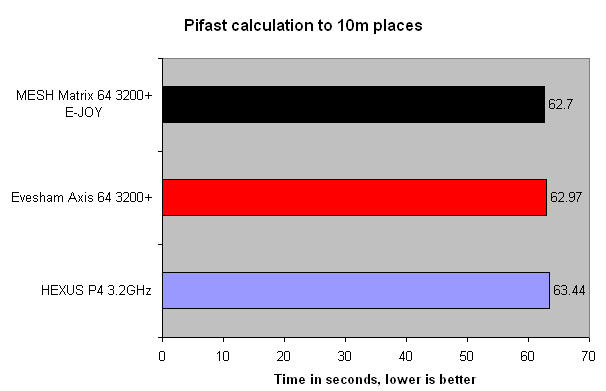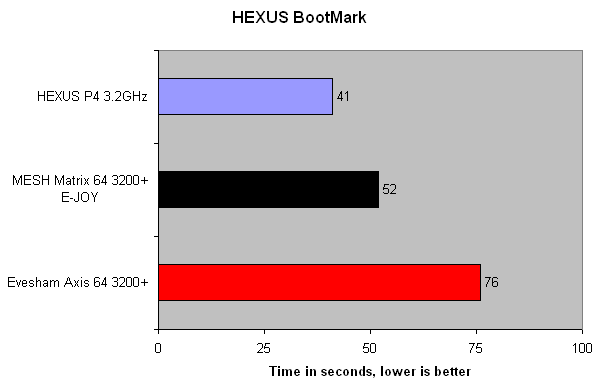ScienceMark 2.0, Pifast, BootMark
MESH's clock speed advantage over the Evesham setup, which equates to around 50MHz, will undoubtedly give it the edge in most benchmarks. As long as MESH supplies the end-user with a PC clocked at the same speed, 2050MHz, we have no real problem with it. The more interesting comparison will present itself in the gaming section and with respect to our Pentium 4 3.2GHz machine.
Surprisingly close between the A64 duo, perhaps helped by the Evesham's 1GB of DRAM. They both do well to manage over 90% efficiency, according to ScienceMark 2.0. The Pentium 4 will always win out here; its dual-channel memory and quad-pumped CPU's architecture means a theoretical 6.4GB/s on tap at 200MHz FSB.

Latency will always favour the review pairing. Again, the Evesham does very slightly better than expected. We've seen latencies, measured in nanoseconds, in the low 40s before, but those have been achieved by Athlon 64 boards that are run with ultra-tight DRAM timings. What our initial look at the memory benchmark shows is that both systems have been configured correctly at the respective factories. That's an important point. How is the general public, who are unaware of what to expect from a given set of specifications, ever really going to know if their machine is setup correctly ?. Here's one advantage over a self-build by a novice user. These machines are invariably a few percentage points behind, say, enthusiasts', but still competitive.

Pifast, our first practical test, bores out much of what's said above. £1500 (inc. VAT) buys you a system that's damn quick. The low 60s barrier was only reached with the introduction of a Pentium 4 running at 3.2GHz. AMD shows that it can do it at 2GHz. You just switch it on, wait for the OS to load, and you're in possession of a high-end PC.

Speaking of booting, each machine was timed to see how long it would take to go from a completely cold start to a perfectly usable desktop. It's not the most scientific of benchmarks, but waiting for the PC to become usable is one of the more irksome aspects of computing. Sure, one could use the Suspend-To-RAM (STR) function that's quicker, however most users still prefer to switch off PCs completely.
The Evesham's time was consistent over three runs. It's the slowest of the bunch due to the time it takes for the on-chip VIA controller to confirm that there's no device present on the second SATA port. You just watch while it blinks away for what seems like an age. Perhaps that's one of the reasons that MESH chose the Promise controller. It still runs through device verification. It, though, doesn't wait half as long. It's poor form to take over a minute for a cutting-edge PC to become usable.









